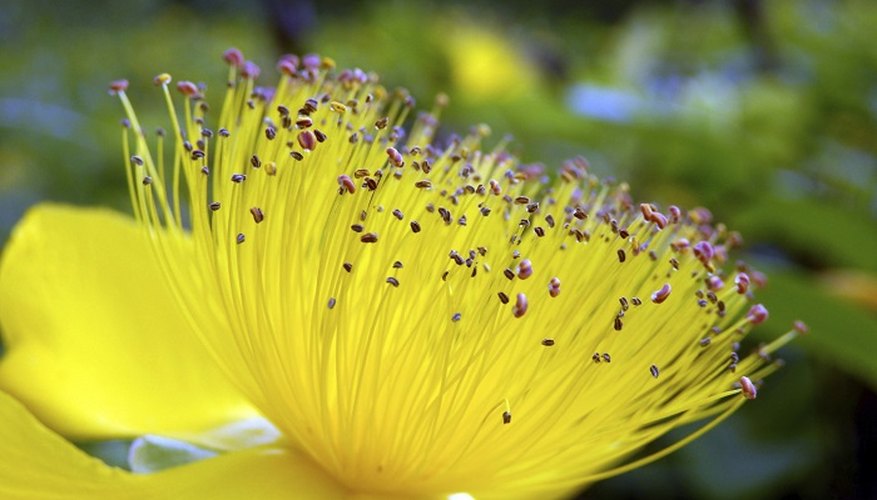Propagating hypericum shrubs is easy and inexpensive. Depending on which variety of hypericum you grow, they can be a pretty and hardy addition to your garden. The variety of hypericum known as St John's wort is a semi-hardwood perennial shrub that is invasive and noxious, but the blooming shrub varieties can be easily propagated. Hypericum shrubs are sturdy and resilient, and will tolerate nearly any soil type; they're resistant to both drought and heat.
Propagating hypericum
Prepare a rooting medium using a mixture of potting soil with a small amount of sand or perlite mixed in. Fill a 15 cm pot (with holes in the bottom) nearly full with the rooting medium, leaving a 2.5 cm space at the top. Position the pot on a small tray of sand or fine gravel to provide good drainage.
Take cuttings from established hypericum. You'll achieve best results with winter cuttings. Use a sharp, clean blade to cut a slender stem that's 10 to 20 cm long. Remove the leaves, if any remain, except for two or three small leaves at the tip of the cutting.
Use a pencil to poke a hole in the potting soil in your container. Make sure the hole is almost as deep as your hypericum cutting. Dip the cut end of the stem into rooting hormone.
Shake off excess rooting hormone and insert the hypericum cutting into the hole in the soil. Push the stem down until just 2.5 to 5 cm of the tip remains above the surface, then gently tamp the soil around the stem so it's in contact with the soil. Repeat these steps if you are starting more than one cutting. Water the soil lightly so it's evenly moist but not soggy.
- Prepare a rooting medium using a mixture of potting soil with a small amount of sand or perlite mixed in.
- Push the stem down until just 2.5 to 5 cm of the tip remains above the surface, then gently tamp the soil around the stem so it's in contact with the soil.
Cover the container and the tray with plastic. Bag the whole thing up in a large transparent plastic bag, use a large plastic tray or lid, or upend a deep glass bowl or baking dish over the top. Keep the covered hypericum cutting in a warm place, but avoid direct sunlight. Add water as necessary to the sand or gravel in the tray to maintain a humid environment for your cutting; you can also mist the top of the cutting with a spray bottle and room-temperature water.
Moving the plant outdoors
Keep the soil moist but not wet; make sure the sand or gravel in the tray is not waterlogged. Keep the cutting in a slightly warm area (15C to 18C, give or take a few degrees). Do not add any type of fertiliser or plant food while the cuttings are becoming established.
Keep the rooted cutting in the container till it shows new growth and resists a very gentle tug -- this indicates it's successfully rooted in the soil. Accustom the hypericum to its new uncovered environment by removing the cover for short periods. Poke holes in the plastic bag or top plastic lid, or prop up the glass cover if that's what you used, to allow a bit more air each day to reach the new plant.
- Keep the soil moist but not wet; make sure the sand or gravel in the tray is not waterlogged.
- Accustom the hypericum to its new uncovered environment by removing the cover for short periods.
Move the potted hypericum outdoors in warm spring weather. Keep the pot in a warm place away from direct sunlight, and bring it back indoors if the weather turns cool. Avoid harsh sun or temperature extremes for a month before planting. Move the potted hypericum gradually to a warm, sunny spot, and plant it in the garden in early summer at the same depth as the stem was in the container.
TIP
Hypericum seeds may be sowed outdoors in early autumn for spring germination.
WARNING
The weedy form of hypericum, St John's wort, is considered invasive and can be poisonous to livestock. Pruning the plants can cause contact dermatitis.
